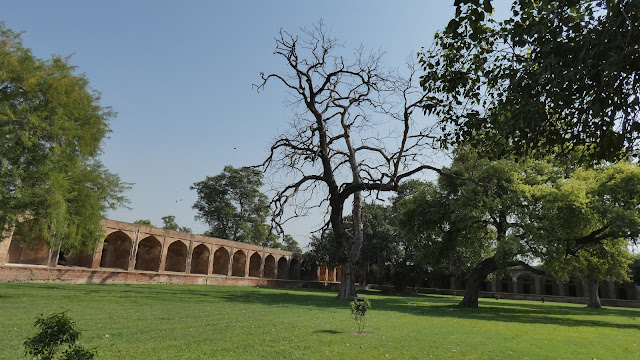In 1637, a mausoleum built by
Mughal Emperor Jahangir is located in Shahdara adjacent to Lahore, Pakistan.
This is called Tomb of Jahangir, along the banks of River Ravi. Emperor
Jahangir, who ruled the Mughal Empire from 1605 to 1627 C.E. The Janangir
mausoleum is most popular due to its fantasist interiors extensively
embellished with frescoes and marbles. This spot had been a favorite area of
Jahangir and his wife Nur Jahan when they resided in Lahore, and this spot was usually
used as a point of departure for travels to and from Kashmir and Lahore.
The Jahangir Tomb along with Akbari Sarai, Tomb of Asif Khan are in the
tentative list of UNESCO World Heritage status. Much of mausoleum’s exterior
that is richly decorated with pietra dura. This was rural area famous for its
many pleasure gardens. The tomb in located in Nur Jahan's pleasure garden, the
Dilkusha Garden, that had been laid out in 1557. The tomb of Jahangir's wife
Nur Jahan is located slight southwest of Asif Khan's tomb. However, the Tomb of
Asif Khan, built in 1645, and the Akbari Sarai, built in 1637, are located
immediately west of Jahangir's tomb complex. Flooding from the nearby River
Ravi threatened or damaged the site sustained water damage during flooding in
1988 that covered much of the site in 10 feet of water for 5 days.
Jahangir was died on 28 October
1627 in the foothills Kashmir when he was on travelling to town of Rajauri. His
dead body was carried from Kashmir to Shahdara on 12 Nov 1627. The Dilkusha
Garden was his favourite spot of Jahangir and his wife Nur Jahan, when they
lived in Lahore. The funeral procession
done by his son (Emperor Shah Jahan) in that place , ordered a mausoleum
befitting an Emperor should be built in his father's honor to inter his
remains. Jahangir has renewed interest in minarets; however some historians
attribute construction of tomb to Jahangir’s son Shah Jahan. Jahangir’s wife
Nur Jahan had vision of constructing tomb, taking inspiration from her father’s
burial place. It is believed, that construction cost was around 10 lakh and it
took three years to finish. The tomb's gardens are laid out in the Persian
Chahar Bagh style. Hence, the construction work of the mausoleum lasted 10
years, from 1627 to 1637, and was most likely funded by the imperial treasury
(though there is some evidence that Jahangir's wife, Nur Jahan, may have
financed the construction).
In 1814, some repair work done by
Sikh rule when they were pillaged by the army of Ranjit Singh, with building
materials used for decoration of the Golden Temple in Amritsar. The tomb
complex, was also desecrated and pillaged grounds were then converted for use
as a private residence for an officer in the army of Ranjit Singh. The monuments suffered further under British
rule, when a railway line was built between the tombs of Asif Khan and Nur
Jahan. The site was then repaired by the British between somewhere 1889-1890.
The tombs walls are inlaid with carved marble.
The walls of the tomb are inlaid
with red sandstone and carved marble motifs. Arcades surround the tomb and
feature ghalib kari, or ribs inlaid into arched surfaces on the arch's curved
areas. The square shaped mausoleum’s is 22 foot tall and roof is embellished with
marble. The building rise four octagonal ornamental minarets decorated with
geometric inlaid stone. The minarets rise to a height of 100 feet and the body
of the minaret rests, called by white marble cupolas. Also, the burial chamber
contains the Emperor's cenotaph. The series of vaulted compartments are richly
adorned with Mughal buon fresco. In the center of the mausoleum is an octagonal
chamber lined with carved marble in which the remains of the Mughal Emperor
rest in a crypt below a cenotaph.
The interior of the tomb features a
white-marble cenotaph inlaid with pietra dura in vegetal patterns, as well as
the 99 Names of Allah, a common theme in Islamic mysticism. The mausoleum is
set in a large quadrangle with gates facing each of the cardinal directions.
Thus, entry to the quadrangle is through the western edge via the Akbari Sarai.
Also there is a gate featuring a small mosque. To the immediate west of the
Akbari Sarai is the Tomb of Asif Khan - Jahangir's brother-in-law. Nowadays,
the tomb of Jahangir holds exceptional significance for Pakistanis as it is the
only Mughal tomb located in present-day Pakistan. Its image appears on the
1,000 rupee banknote and it remains one of Lahore's most popular attractions.
Source: CP






























No comments:
Post a Comment